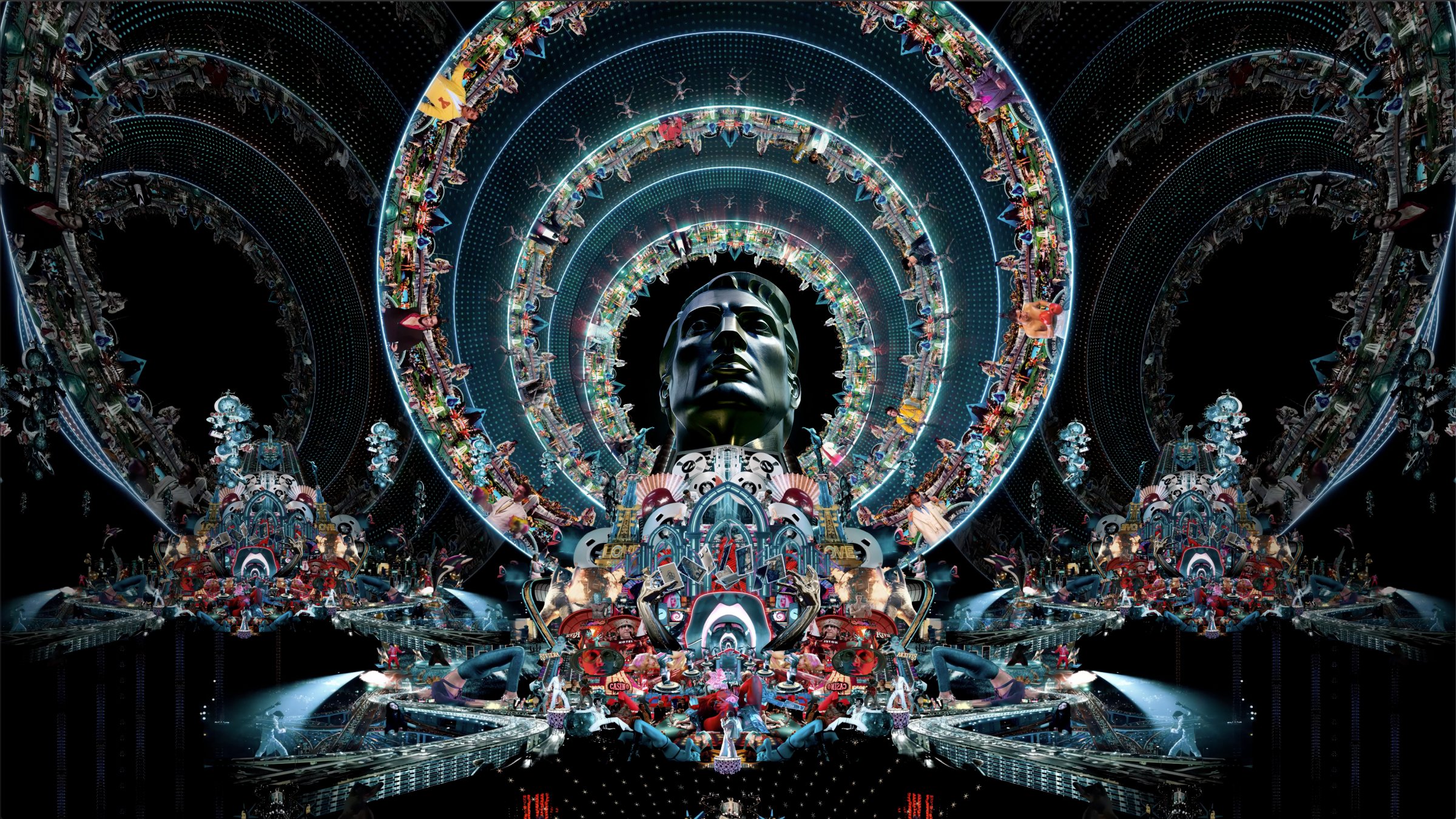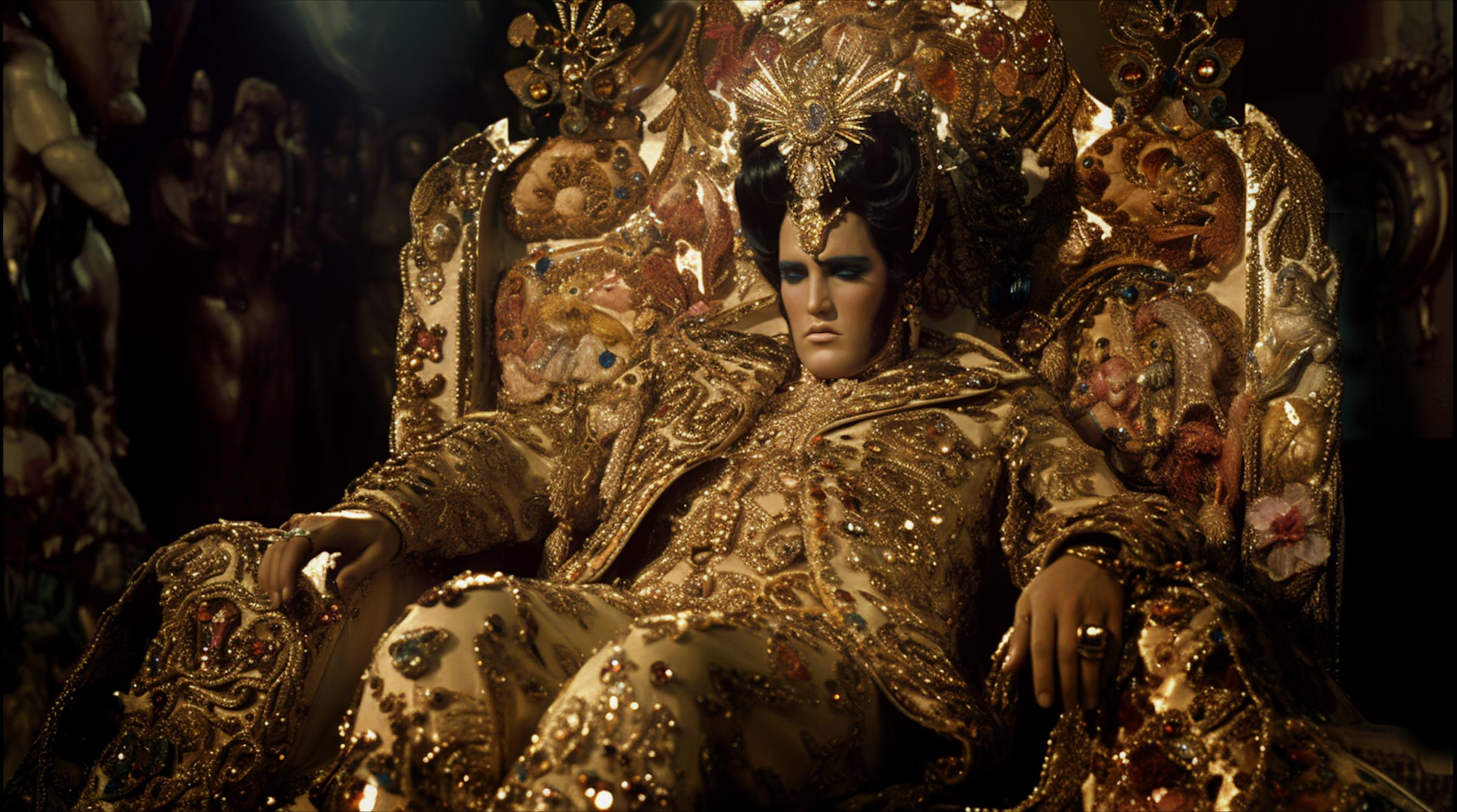
It’s impossible to avoid Elvis Presley in Las Vegas: his image appears on street art and photographs, while impersonators can be found all over the strip. But starting on Friday, the King of Rock and Roll will get possibly his largest tribute yet: a video collage that renders him hundreds of times, projected hundreds of feet into the air, in incarnations young and old, gyrating and reclining, in bas relief and gold, all thanks to a technology created long after his death: generative AI.
The video collage is the creation of the artist Marco Brambilla, the director of Demolition Man and Kanye West’s “Power” music video, among many other art projects. Brambilla fed hours of footage from Presley’s movies and performances into the AI model Stable Diffusion to create an easily searchable library to pull from, and then created surreal new images by prompting the AI model Midjourney with questions like: “What would Elvis look like if he were sculpted by the artist who made the Statue of Liberty?”
The kaleidoscopic result, called “King Size,” will make its debut as part of U2’s concert performance at the opening night of the Sphere, a $2.3 billion entertainment venue that sits a block from the Las Vegas Strip and hopes to be the city’s latest colossal entertainment mecca. The Sphere is 366 feet tall, with its creators claiming it boasts the world’s largest spherical structure and the world’s highest-resolution wraparound LED screen.
Brambilla created an exclusive video excerpting from the larger collage for TIME. You can watch it above.
While Brambilla’s Elvises prance across the Sphere’s screen—which is four times the size of IMAX— the band U2 will perform their song “Even Better Than The Real Thing,” as part of their three-month residency at the Sphere celebrating their 1991 album Achtung Baby. The members of U2 have long been massive fans of Elvis, with Bono even penning a letter about his love for the singer in Rolling Stone in 2020. Earlier this year, U2 commissioned several artists, including Brambilla and Jenny Holzer, to create visual works that would accompany their performances of specific songs.
Given U2’s love for the singer and the lavish setting of the Sphere, Brambilla thought a tribute to Elvis would be extremely fitting. He wanted to create a maximalist work that encapsulated both the ecstatic highs and grimy lows of not only Elvis, but the city of Las Vegas itself. “The piece is about excess, spectacle, the tipping point for the American Dream,” Brambilla said in a phone interview.
Brambilla was only given three-and-a-half months to execute his vision, less than half the time that he normally spends on video collages. So he turned to AI tools for both efficiency and extravagance. “AI can exaggerate with no end; there’s no limit to the density or production value,” Brambilla says. And this seemed perfect for this project, because Elvis became a myth; a larger-than-life character.”
First, Brambilla fed clips from dozens of movies starring or depicting Elvis into Stable Diffusion, which allowed him to catalog hours of footage and select what he needed with ease. For example, he could simply search his dataset for “crowd in a concert,” and the AI model would pull all of the related clips up immediately for his sampling.
He then used both Stable Diffusion and Midjourney, another AI model, to generate the fantastical versions of Elvis and his accessories: Statue of Liberty Elvis; an Elvis that rising from a casino table out of piles of coins; a surrealist Salvador Dali-style guitar; a statue of the singer’s head modeled off the imposing stainless steel sculptures by Isamo Noguchi at Rockefeller Center.
One of the exact prompts he entered was: “Elvis Presley in attire inspired by the extravagance of ancient Egypt and fabled lost civilizations in a blissful state. Encircling him, a brigade of Las Vegas sorceresses, twisted and warped mid-chant, reflect the influence of Damien Hirst and Andrei Riabovitchev, creating an atmosphere of otherworldly realism, mirroring the decadence and illusion of consumption."

Brambilla says that only about 20% of the output images actually looked like Elvis. “But some really interesting accidents came out of it,” he says. “It was a stream-of-consciousness experiment: You’re working with a tool prompting you to make associations you wouldn’t have made.”
Brambilla transplanted his MidJourney-created images into CG (computer graphics) software, where he could better manipulate them, and left some of the Stable Diffusion Elvis incarnations as they were. The result is a kaleidoscopic and overwhelming video collage filled with video clips both historical and AI-generated, that will soon stretch hundreds of feet above the audience at each of U2’s concerts.
“I wanted to create the feeling that by the end of it,” Brambilla says, “We’re in a place that is so hyper-saturated and so dense with information that it's either exhilarating or terrifying, or both.”
More Must-Reads from TIME
- Cybersecurity Experts Are Sounding the Alarm on DOGE
- Meet the 2025 Women of the Year
- The Harsh Truth About Disability Inclusion
- Why Do More Young Adults Have Cancer?
- Colman Domingo Leads With Radical Love
- How to Get Better at Doing Things Alone
- Michelle Zauner Stares Down the Darkness
Contact us at letters@time.com